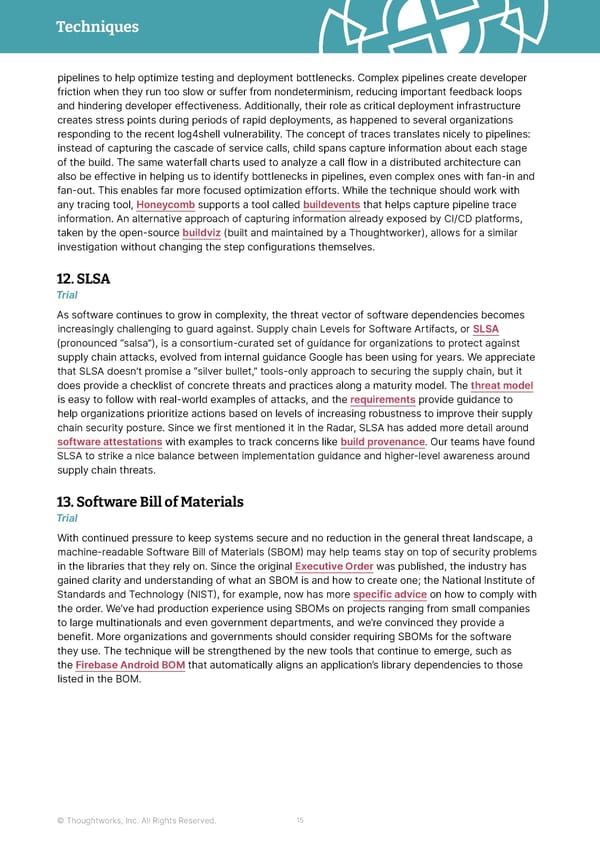Techniques Thoughtworks Technology Radar pipelines to help optimize testing and deployment bottlenecks. Complex pipelines create developer friction when they run too slow or suffer from nondeterminism, reducing important feedback loops and hindering developer effectiveness. Additionally, their role as critical deployment infrastructure creates stress points during periods of rapid deployments, as happened to several organizations responding to the recent log4shell vulnerability. The concept of traces translates nicely to pipelines: instead of capturing the cascade of service calls, child spans capture information about each stage of the build. The same waterfall charts used to analyze a call flow in a distributed architecture can also be effective in helping us to identify bottlenecks in pipelines, even complex ones with fan-in and fan-out. This enables far more focused optimization efforts. While the technique should work with any tracing tool, Honeycomb supports a tool called buildevents that helps capture pipeline trace information. An alternative approach of capturing information already exposed by CI/CD platforms, taken by the open-source buildviz (built and maintained by a Thoughtworker), allows for a similar investigation without changing the step configurations themselves. 12. SLSA Trial As software continues to grow in complexity, the threat vector of software dependencies becomes increasingly challenging to guard against. Supply chain Levels for Software Artifacts, or SLSA (pronounced “salsa”), is a consortium-curated set of guidance for organizations to protect against supply chain attacks, evolved from internal guidance Google has been using for years. We appreciate that SLSA doesn’t promise a “silver bullet,” tools-only approach to securing the supply chain, but it does provide a checklist of concrete threats and practices along a maturity model. The threat model is easy to follow with real-world examples of attacks, and the requirements provide guidance to help organizations prioritize actions based on levels of increasing robustness to improve their supply chain security posture. Since we first mentioned it in the Radar, SLSA has added more detail around software attestations with examples to track concerns like build provenance. Our teams have found SLSA to strike a nice balance between implementation guidance and higher-level awareness around supply chain threats. 13. Software Bill of Materials Trial With continued pressure to keep systems secure and no reduction in the general threat landscape, a machine-readable Software Bill of Materials (SBOM) may help teams stay on top of security problems in the libraries that they rely on. Since the original Executive Order was published, the industry has gained clarity and understanding of what an SBOM is and how to create one; the National Institute of Standards and Technology (NIST), for example, now has more specific advice on how to comply with the order. We’ve had production experience using SBOMs on projects ranging from small companies to large multinationals and even government departments, and we’re convinced they provide a benefit. More organizations and governments should consider requiring SBOMs for the software they use. The technique will be strengthened by the new tools that continue to emerge, such as the Firebase Android BOM that automatically aligns an application’s library dependencies to those listed in the BOM. © Thoughtworks, Inc. All Rights Reserved. 15
 Vol 27 | Technology Radar Page 14 Page 16
Vol 27 | Technology Radar Page 14 Page 16